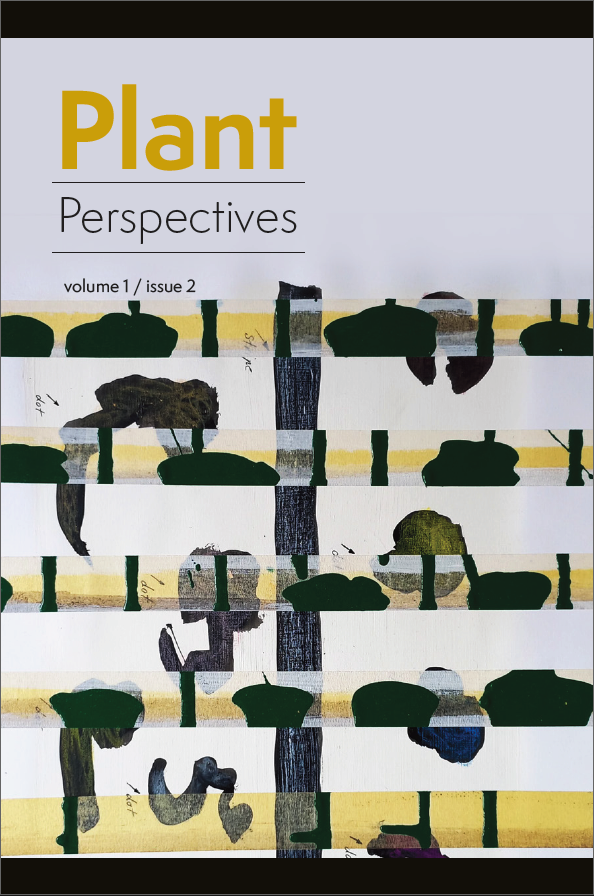Published 2024-10-17
Keywords
- Dance and Performance Studies,
- Critique of Anthropocentrism,
- Minor Performances,
- Politics of Preposition,
- Decolonising
How to Cite
Copyright (c) 2024 Gabriele Brandstetter

This work is licensed under a Creative Commons Attribution 4.0 International License.
Abstract
This article examines the intricate interplay between humans and plants within the context of contemporary dialogues surrounding the climate crisis and the evolving dynamics of human and more-than-human relationships in the Anthropocene. With a particular focus on dance and performance, the article explores how networks of plants manifest in and influence artistic expressions. It scrutinises anthropocentric perspectives embedded in both scholarly discourses and artistic practices related to plant interactions. By delving into the nuanced variations in these relationships, as expressed through the use of prepositions such as ‘about’ plants, ‘as’ plants, ‘with’ plants and ‘for’ plants, the article aims to unveil how dance and performance have grappled with dismantling the hierarchical structures and colonising practices that often define the connections between humans and plants over the course of the twentieth century and up to the present day. The discussion extends to an analysis of whether there exists a potential for degrowth and an ethical alignment encapsulated in collaborative performances, exemplified by Ruth Geiersberger’s ‘For Plants’ (2020). Additionally, the article explores the transformative potential of ‘minor performances’ in reshaping and decolonising hierarchical dynamics in the intricate tapestry of human-plant relationships. Through this examination, the article seeks to contribute to the ongoing discourse on fostering languages of resonance and envisioning a more harmonious coexistence in the face of environmental challenges.
References
- Brand, U. 2022. ‘Postwachstum! [Post-Growth!]’. Springerin 3: 26–29.
- Breidbach, O. and I. Eibl-Eibesfeldt (eds). 2004. Ernst Haeckel: Kunstformen der Natur - Die einhundert Farbtafeln [Art Forms of Nature – The One Hundred Color Plates]. München: Prestel.
- Clark, N. 2010. Inhuman Nature: Sociable Life on a Dynamic Planet. New York: Sage Publishing.
- Coccia, E. 2016. La vie des plantes: Une métaphysique du mélange [Plant Life: A Metaphysics of Mixing]. Paris: Éditions Payot et Rivages.
- Coccia, E. 2019. ‘Pflanzenphilosophie: Die Wurzeln der Welt [Plant Philosophy: The Roots of the World]’. In K. Meyer and J.E. Weiss (eds), Von Pflanzen und Menschen: Leben auf dem grünen Planeten [About Plants and People: Life on the Green Planet], pp. 32–38. Göttingen: Wallstein Verlag.
- Deleuze G. and F. Guattari. 1976. Kafka: Für eine kleine Literatur [Kafka: Toward a Minor Literature]. Frankfurt a.M.: Suhrkamp.
- Dürbeck, G. and P. Hüpkes (eds). 2021. Narratives of Scale in the Anthropocene: Imagining Human Responsibility in an Age of Scalar Complexity. New York: Routledge. https://doi.org/10.4324/9781003136989
- Eikels, K. v. 2013. Die Kunst des Kollektiven: Performance zwischen Theater, Politik und Sozio-Ökonomie [The Art of the Collective: Performance between Theater, Politics and Socio-Economics]. Paderborn: Fink.
- Esposito, R. 2004. Communitas: Ursprung und Wege der Gemeinschaft [Origins and Ways of Community]. Berlin: Diaphanes.
- Goethe, Wolfgang von. 1878. Poems: Translated in the Original Metres, trans. P. Dyrsen. New York: F.W. Christern.
- Habermalz, C. (n.d.). How to Become an Eco-Guerrillera/Guerrillero. Flyer.
- Haraway, D. 2003. The Companion Species Manifesto: Dogs, People and Significant Otherness. Chicago: Prickly Paradigm Press.
- Haraway, D. 2016. Staying with the Trouble: Making Kin in the Chthulucene. Durham and London: Duke University Press. https://doi.org/10.2307/j.ctv11cw25q
- Horn, E. and H. Bergthaller (eds). 2019. Anthropozän: Zur Einführung [Anthropocene: An Introduction]. Hamburg: Junius.
- Jacobs, J. 2020. ‘Exhibiting plants: Curating the gaze on vegetal beings’. Antennae: The Journal of Nature in Visual Culture 52: 193–201.
- Marchart, O. 2019. Conflictual Aesthetics. Artistic Activism and the Public Sphere. Berlin: Sternberg Press.
- Mattenklott, G., A. Wilde and J. Wilde. 1997. Karl Blossfeldt: Alphabet der Pflanzen [Alphabet of Plants]. München: Schirmer/Mosel.
- Meyer, K. and J.E. Weiss (eds). 2019. Von Pflanzen und Menschen: Leben auf dem grünen Planeten [About Plants and People: Life on the Green Planet]. Göttingen: Wallstein Verlag.
- Nancy, J.-L. 2000. Being Singular Plural. Stanford: Stanford University Press. https://doi.org/10.1515/9781503619005
- Nancy, J.-L. 2022. ‘Des Atems beraubt [Deprived of Breath]’. Lettre International 139: 6–10.
- Preiwuß, K. 2019. Das Komma und das Und: Eine Liebeserklärung an die Sprache [The Comma and the Ampersand: A Declaration of Love for Language]. Berlin: Dudenverlag.
- Rheinberger, H. 2005. Iterationen [Iterations]. Berlin: Merve Verlag.
- Scherer, B. 2022. ‘Sensing reality and possibility in the new geological epoch: The partnership between Haus der Kulturen der Welt and the Anthropocene Working Group’. In K. Klingan (ed.), Earth Indices: Processing the Anthropocene, pp. 3–4. Berlin: Haus der Kulturen der Welt. https://doi.org/10.1017/9781009042369.014
- Vetter, A. 2022. ‘Konviviale Technik: Eine Bauanleitung in acht Schritten [Convivial Technology: A Construction Manual in Eight Steps]’. Springerin 3: 32–36.
- Voigt, K.C., L. Beiersdorf and P. Müller-Tamm (eds). 2021. Inventing Nature: Pflanzen in der Kunst [Inventing Nature: Plants in the Arts]. Karlsruhe and Köln: Snoeck.
- Wittrock, E. 2016. ‘Tropismus als Tanz. Blumenzeitraffer als Bewegungsmodell der Moderne’. In Alexander Schwan, Isabel Kranz and Eike Wittrock (eds), Floriographie: Die Sprachen der Blumen, pp. 245–58. Leiden: Brill. https://doi.org/10.30965/9783846759943_012
- Woods, D. 2014. ‘Scale critique for the Anthropocene’. Minnesota Review 83 (1): 133–42. https://doi.org/10.1215/00265667-2782327
- Ziemer, G. 2016. Complicity: New Perspectives on Collectivity. Bielefeld: transcript Verlag. https://doi.org/10.1515/9783839435175

